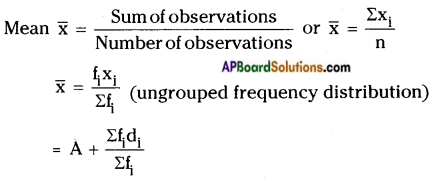Students can go through AP Board 9th Class Maths Notes Chapter 9 Statistics to understand and remember the concepts easily.
AP State Board Syllabus 9th Class Maths Notes Chapter 9 Statistics
→ The facts or figures which are numerical or otherwise collected with a definite purpose are called data.
→ Statistics is the branch of mathematics which studies about the data and its meaning.
→ The information collected by the investigator with a definite objective is called primary data.
→ The information collected from a source, which had already been recorded lay from registers is called secondary data.
→ Data exists in raw form.
![]()
→ Data is classified into groups to make the study easy.
→ The difference between the minimum and maximum values of a data is called the range of the given data.
→ The table showing the actual observations with their frequencies is called ungrouped frequency distribution table or table of weighted observations.
→ Presenting the data in groups with their frequencies is called a grouped frequency distribution table.
→ Mean, Median and Mode are called the measures of central tendency.

(Deviation method: ∑fidi – sum of the deviations, A – assumed mean and ∑fi – sum of the frequencies)
→ Median is the middle observation of a data, when arranged in either ascending/ descending order.
→ When number of observations ‘n’ is odd, the median is \(\left(\frac{n+1}{2}\right)^{th}\) observation.
→ When number of observations ‘n’ is even, the median is \(\left(\frac{n}{2}\right)^{th}\) the average of \(\left(\frac{n}{2}+1\right)^{th}\) observations.
![]()
→ Median divides the data into two groups of equal number, one part comprising all values greater and the other comprising all values less than median.
→ Mode is the value of the observation which occurs most frequently, i.e., an observation with the maximum frequency is called mode.
→ If each of the observation is added or multiplied by same quantity, the measure of central tendency also changes accordingly.